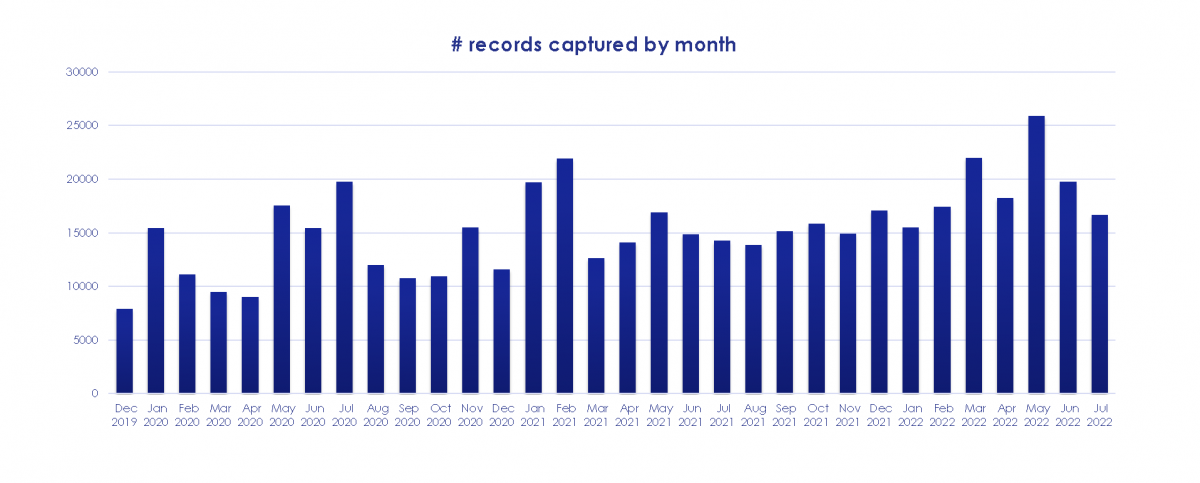Automating Records Capture at the University of Western Australia (UWA)

The University of Western Australia is the oldest university in WA, opening in 1913 with just 184 students. Today, there are more than 27,000 students, and their activity generates an average of around 250,000 individual student records annually which need to be captured into Micro Focus Content Manager.
The core function student records account for about 55-60% of the total amount of records that are captured annually to Content Manager, which has been used at UWA since 1998.
I have been working in the records team at UWA for 18 years and I have been the manager of the team since 2007. Over that time there have been numerous changes in the tools, processes, and practices used to support the management of the records of the University within Content Manager.
Of those changes, which are too numerous to list separately, I can confidently state that the most significant change in terms of positive impact on record-keeping efficiency and effectiveness, was and is the implementation of automated records capture to Content Manager using EzeScan, which commenced in December 2019.
By 2018, some student processes, such as applications for admission, had transitioned to fully digitalised workflows. But almost 40% of the student records were still generated by paper-based processes then captured to CM occurred via a digitisation service delivered by the records team.
Where records were born digital, they were primarily captured by bulk import (50%) or manually captured by end users (10%). These proportions had remained stable since about 2014 despite ongoing efforts to digitalise student processes.
So, what was stopping UWA in digitalising its student processes when the benefits of doing so were well understood and accepted?
The short answer is resourcing, but, in hindsight, the existence of the student records digitisation service, which has remained in operation since electronic student files were implemented at UWA in 2002, was the key barrier to digitalisation.
There was a very strong reluctance to commit to digitalisation of student processes if manual capture of the resulting records to CM was required. There was no identifiable benefit for end users and the benefits for the records team - in terms of a reduced volume of material requiring digitisation - were invisible to the wider University.
This barrier was also exacerbated by a whole-of-university restructure that took effect in 2017, resulting in a significant loss of corporate knowledge and an understandable negative impact on staff morale. The records team were now reporting to University Library rather than to IT Services
The only possible conclusion was that the records team needed to remove the requirement for manual records capture in order to encourage the digitalisation. We needed an automated records capture solution.
To be clear, the implementation of automated records capture had long been the ultimate goal for the UWA records team, but the prevailing circumstances had not been aligned with or supportive of that goal until 2018.
As such, we commenced work to identify and acquire this solution by undertaking a review of the products available that supported both digitisation and automated records capture.
What was the solution we identified?
EzeScan was identified as the best fit for the University context because it supported the continuing requirement for digitisation while also supporting automated records capture.
It integrates with Content Manager out of the box, and it is flexible in that it supports the digitisation of a wide variety of different types of records, unlike some other products that focus on supporting the digitisation of a large volume of a small number of document types such as invoices. EzeScan is a better match for the scope and scale of the digitisation service delivered by the UWA records team.
EzeScan was the most cost-effective option that supported automated records capture and the licensing model was simple and could be modified over time to expand functionality. This was important as it supported the planned transition away from digitisation towards automated capture without having to maintain two different products.
Finally, as has been demonstrated at UWA, once automation routes and digitisation routes are configured in EzeScan they are simple to maintain and to expand or amend as needed.

EzeScan was initially implemented to support digitisation in May 2018 as a replacement to our previous digitisation application.
It then took until December 2019 to enable automated records capture to Content Manager via implementation of the EzeScan Server module, including email records capture. We implemented the service to auto-capture admissions application records that had previously been captured via regular bulk imports, along with a subset of admissions related emails that had previously been manually captured to TRIM by the Admissions team.
In hindsight this timing was extremely fortuitous given the extreme disruption that occurred in early 2020 with the emergence of the COVID-19 pandemic. While the pandemic has been very damaging for the University sector overall, it did have the benefit of clearly demonstrating the need to manage records digitally as staff and students transitioned to working from home.
This lead directly to the implementation of an automated capture route for special consideration applications for deferred exams in June 2020. 1800 of these applications were captured automatically to CM during the remainder of 2020, where previously these records would have been submitted via paper forms and digitised by the records team.
In October 2020 UWA implemented a new research administration system to assist UWA researchers to apply for and manage research grants and research ethics approvals. Due to the existence of the auto-capture service, and because Research Administration records had been managed electronically in Content Manager since 2006, we were able to successfully implement automated capture of the records arising from this system, including the automated creation of Container records, despite the challenges of working from home for the bulk of the system implementation project.
In January 2021 we expanded the existing route used to capture admissions documents to enable the capture of student proof-of-ID records. This meant that the records team was no longer responsible for the manual capture of up to 5000 born-digital records annually. This was an example of a process we had been able to digitalise but only by having the records team take on the responsibility for manually capturing the records.
In August 2021 the auto-capture of applications for special consideration was expanded to all types of special consideration. Previously this process had been the source of the highest number of records by volume that required digitisation by the records team. The automation of this process had long been a primary goal.
In December 2021 we configured a route to enable the capture of HR documents on to Staff Files in TRIM. This did not go live until January of this year when all university staff working on Campus had to produce proof-of-COVID19 vaccination - more than 4500 separate records were captured via this route in February of 2022 alone.
In January 2022 we also introduced a route to enable the capture of student special approval applications which was another high priority student process for the records team due to the volume of these applications submitted annually.
I want to take this opportunity to thank the EzeScan support team, in particular Tony Mulvihill, as he and they are always very responsive to any of the rare issues we have, and have they been able to accommodate the quirks of how we use Content Manager at UWA, including our insistence on using classification titling for documents which I understand in unique amongst CM users.
We recently upgraded to EzeScan 5 as part of our upgrade to Content Manager 10 and the improvements included in this version have reduced the number of exceptions that are generated by our research admin routes and therefore improved auto-capture efficiency.
We are also using EzeScan to support the work of the Digitisation Centre of WA which is working to digitise the major humanities arts and social sciences collections held in WA to archival standards.
Lessons learnt
Finally, some lessons from the implementation of automated records capture to CM via EzeScan at UWA.
Firstly, don’t try to automate everything at once - start small with processes that are already digitally mature and then expand, and use the success of implemented workflows as proof of concept to encourage engagement across diverse teams and processes.
Secondly, take advantage of new business system implementations, existing mature digitalised processes and don’t discount the potential value of disruptive events such as global pandemics or changes in reporting lines.

This table shows the number of records auto-captured by month since the implementation of the service at UWA. There has been a general increase in the volume of records we are auto-capturing over time as existing routes are expanded and new routes are added.
The peak in January 2020 reflects the admissions process, which is most active in January, processing applications for admission, while the peak from May to June of 2020 reflects a general increase in mid-year applications for admission from domestic students due to the closed borders along with the processing of applications for deferred exams.
The November 2020 peak relates to the influx of records from the new Research Administration system and the peak in Jan/Feb 2021 relates to the normal admission process peak along with the capture of student proof of ID records.
The peak in May 2022 reflects the expected increase in applications for special consideration that always occur at the end of semester although the actual volume of these applications processed this year is significantly more than usual - this is directly due to COVID-19.

These charts show the change in capture method for student records from 2018 prior to auto-capture compared to 2021 post-auto-capture. It clearly demonstrates the benefits, particularly in terms of the reduction in digitisation, which accounted for 38% of student records captured to CM in 2018 but only 12% of student records captured in 2021.
